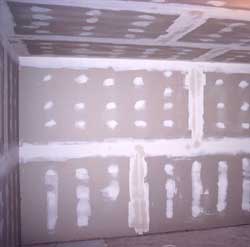 Drywall texture varies for ceilings and walls. In this article, we'll focus on the most common textures used in new construction to speed up process. Rather than worrying about getting a perfectly smooth surface, builders can spray drywall texture with a machine to save time and money.
Drywall texture varies for ceilings and walls. In this article, we'll focus on the most common textures used in new construction to speed up process. Rather than worrying about getting a perfectly smooth surface, builders can spray drywall texture with a machine to save time and money.
These sprayer applied drywall texture work well until until it's time to repair the drywall. You now have to repair the drywall and match the textured surface and instead of working in an open space, you've got the added challenge of working around furniture and finished floors.
Here are the added challenges of repairing drywall that includes a texture.
- Matching the same consistency of drywall mud that was used when the original texture was applied.
- Using the same technique and tools to apply the drywall texture, which isn't practical because most drywall spraying takes place in unfurnished houses.
- Feathering out the mud covering new drywall seams is difficult as you meet the surrounding drywall texture and the mud gets trapped in the texture crevices.
In Drywall Repairs Can Be Challenging, we explored the skills required to handle small and larger drywall repairs. Here we focus on the 3 most common drywall textures, which add more complexity to doing drywall repairs.
Popcorn Drywall Texture
 Everyone's heard of popcorn ceilings, the most common drywall texture used for ceilings but effective at covering up imperfections in the ceiling drywall. Popcorn ceilings popular in the 1960s and 1970s make a house look dated so most homeowners want to remove it. When you need to repair a popcorn ceiling, you can choose to:
Everyone's heard of popcorn ceilings, the most common drywall texture used for ceilings but effective at covering up imperfections in the ceiling drywall. Popcorn ceilings popular in the 1960s and 1970s make a house look dated so most homeowners want to remove it. When you need to repair a popcorn ceiling, you can choose to:
- Use spray cans of premixed acoustic texture (another name for the popcorn texture) that can be found at home improvement or hardware stores. Test the texture to match the popcorn size and distance for spraying to get coverage that matches.
- Remove the popcorn texture which can be messy and time consuming, especially if it's been painted. To learn more about what's involved, read Drywall 101's article, Removing Popcorn Texture.
- Be aware that most popcorn drywall texture sprayed before 1978 contained asbestos. You should only attempt to remove ceiling popcorn yourself after confirming the absence of asbestos which has been linked to a form of cancer known as Mesotheleoma.
Orange Peel Drywall Texture
 The orange peel drywall texture comes from spraying on drywall (also called joint) compound that has been thinned, but not so much that it will run when sprayed. The look will vary depending on the size of the sprayer nozzle and how far away from the wall you are. The sprayer literally splatters the mud into thousands of small droplets onto the ceiling or walls, creating a surface that looks like the peel of an orange.
The orange peel drywall texture comes from spraying on drywall (also called joint) compound that has been thinned, but not so much that it will run when sprayed. The look will vary depending on the size of the sprayer nozzle and how far away from the wall you are. The sprayer literally splatters the mud into thousands of small droplets onto the ceiling or walls, creating a surface that looks like the peel of an orange.
Similar to popcorn repairs, you can buy spray cans of orange peel texture. You'll want to practice spraying and be careful to not over spray. Here's a video from the ArmchairBuilder that goes into more detail on adding the orange peel texture over a drywall repair. You'll want to paint the entire wall to help blend the repair.
A Drywall Texture Called Knockdown
 Sometimes you have to wonder where these names come from. The name knockdown comes from the process of flattening or “knocking down” the bubbles or blobs of mud that you get when spraying (splattering) orange peel texture.
Sometimes you have to wonder where these names come from. The name knockdown comes from the process of flattening or “knocking down” the bubbles or blobs of mud that you get when spraying (splattering) orange peel texture.
Knockdown drywall texture is the most expensive of the sprayer textures. The added cost comes from the second step in the process which is manual. After the sprayed “orange peel” compound has begun to dry, a wide drywall knife is used to flatten out the blogs, to create a bumpy texture. Every application is unique with large and small spots and you'll find it provides flexibility when applying the texture on top of drywall repairs.
Do you have a drywall repair story to share?




Leave a Reply